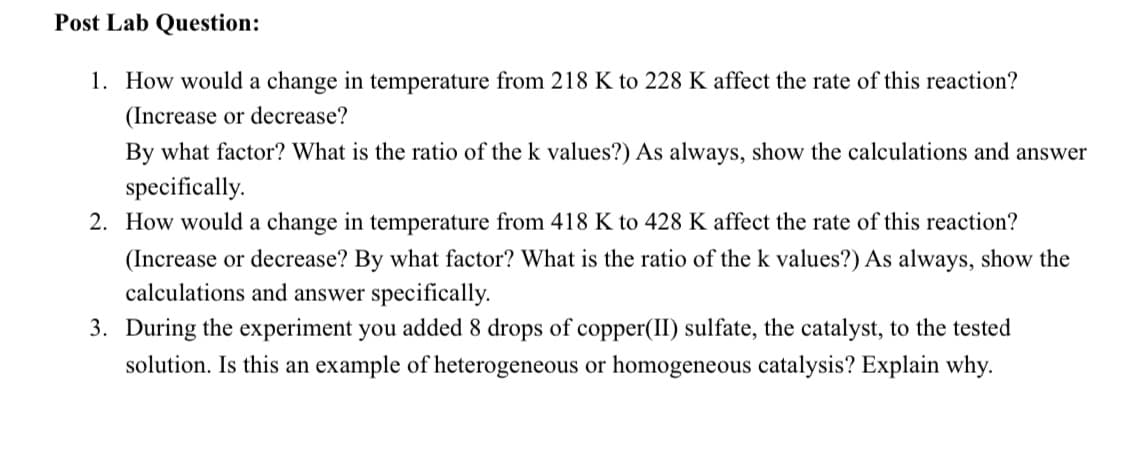Post Lab Question: 1. How would a change in temperature from 218 K to 228 K affect the rate of this reaction? (Increase or decrease? By what factor? What is the ratio of the k values?) As always, show the calculations and answer specifically. 2. How would a change in temperature from 418 K to 428 K affect the rate of this reaction? (Increase or decrease? By what factor? What is the ratio of the k values?) As always, show the calculations and answer specifically. 3. During the experiment you added 8 drops of copper(II) sulfate, the catalyst, to the tested solution. Is this an example of heterogeneous or homogeneous catalysis? Explain why.
Post Lab Question: 1. How would a change in temperature from 218 K to 228 K affect the rate of this reaction? (Increase or decrease? By what factor? What is the ratio of the k values?) As always, show the calculations and answer specifically. 2. How would a change in temperature from 418 K to 428 K affect the rate of this reaction? (Increase or decrease? By what factor? What is the ratio of the k values?) As always, show the calculations and answer specifically. 3. During the experiment you added 8 drops of copper(II) sulfate, the catalyst, to the tested solution. Is this an example of heterogeneous or homogeneous catalysis? Explain why.
Chemistry: Matter and Change
1st Edition
ISBN:9780078746376
Author:Dinah Zike, Laurel Dingrando, Nicholas Hainen, Cheryl Wistrom
Publisher:Dinah Zike, Laurel Dingrando, Nicholas Hainen, Cheryl Wistrom
Chapter16: Reaction Rates
Section16.2: Factors Affecting Reaction Rates
Problem 17SSC
Related questions
Question
Reaction of interest : S2O82-(aq) + 3I- (aq)→ 2SO42-(aq) + I3-(aq). rate= k[S2O82-]1[I-]1.

Transcribed Image Text:Post Lab Question:
1. How would a change in temperature from 218 K to 228 K affect the rate of this reaction?
(Increase or decrease?
By what factor? What is the ratio of the k values?) As always, show the calculations and answer
specifically.
2. How would a change in temperature from 418 K to 428 K affect the rate of this reaction?
(Increase or decrease? By what factor? What is the ratio of the k values?) As always, show the
calculations and answer specifically.
3. During the experiment you added 8 drops of copper(II) sulfate, the catalyst, to the tested
solution. Is this an example of heterogeneous or homogeneous catalysis? Explain why.
Expert Solution
This question has been solved!
Explore an expertly crafted, step-by-step solution for a thorough understanding of key concepts.
This is a popular solution!
Trending now
This is a popular solution!
Step by step
Solved in 2 steps with 2 images

Knowledge Booster
Learn more about
Need a deep-dive on the concept behind this application? Look no further. Learn more about this topic, chemistry and related others by exploring similar questions and additional content below.Recommended textbooks for you

Chemistry: Matter and Change
Chemistry
ISBN:
9780078746376
Author:
Dinah Zike, Laurel Dingrando, Nicholas Hainen, Cheryl Wistrom
Publisher:
Glencoe/McGraw-Hill School Pub Co

Chemistry: Matter and Change
Chemistry
ISBN:
9780078746376
Author:
Dinah Zike, Laurel Dingrando, Nicholas Hainen, Cheryl Wistrom
Publisher:
Glencoe/McGraw-Hill School Pub Co